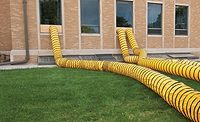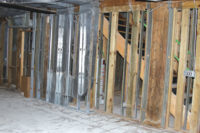The effective use of disinfectants as part of our strategy to return contaminated surfaces to a sanitary condition has been known for many years. The scientific discovery of disinfectants is credited to Joseph Lister who used carbolic acid (phenol) beginning in the 19th century. In 1946, the CDC opened its doors, then known as the Communicable Disease Center. Today we know it as the Centers for Disease Control and Prevention, and it works with the EPA, the regulatory agency that approves disinfectants. The CDC is also the regulatory agency that oversees compliance that can result in a contractor being fined for non-compliance of rules.
By law, all applicable label instructions on EPA-registered products must be followed. If the contractor selects exposure conditions that differ from those on the EPA-registered product label (e.g., inadequate concentration, inadequate dwell time, improper use) the user assumes all liability for any injuries resulting from “off-label” use and is potentially subject to enforcement action under the Federal Insecticide, Fungicide, and Rodenticide Act (FIFRA), factors including, temperature, pH, contact time, active ingredients, and coverage to name a few. Of all the reasons to use disinfectants and protectors, liability may be the most noteworthy.
Professionals should understand the difference between cleaners (e.g., detergents, solvents) sanitizers (e.g., reduces but does not eliminate microorganisms), disinfectants (antimicrobials registered by the EPA to kill or inactivate) and biostats (e.g., EPA-registered products that prevent growth, surface protectors) in order to limit liability. Cleaning should always be conducted with care to remove as much soil, dirt, dust, organic matter and germs (e.g., bacteria, mold, viruses) as possible.
We have long known that cleaning agents work by helping to remove unwanted substances from surfaces. Effective cleaning is a major factor when using disinfectants and surface protectors due in part to their effect on organic and inorganic load present; type and amount of microbial contamination; concentration and effectiveness of exposure or dwell time of disinfectant (the user assumes all liability under circumstances including inadequate dwell time or insufficient coverage); complexity of surface (e.g., cracks, crevices, roughness, and porosity); presence of biofilms; temperature and pH of the disinfection process and, in some cases, hardness of water. Biofilms are important to remove. They are microbial communities that are tightly attached to surfaces that detergents can help degrade. It should be no surprise to professionals that EPA-registered disinfectants work by killing or inactivating many microorganisms on surfaces and should be applied to surfaces following effective cleaning. Thorough cleaning cannot be over emphasized - it is essential before application of disinfectants and protectors.
The CDC guide for the appropriate selection and use of EPA-registered products has undergone important changes. Additionally, emerging pathogens, bioterrorist agents, and blood-borne pathogens are of greater concern today than ever before. Ebola is one of several emerging viruses of great interest to consumers even though influenza is more of a risk to human beings. In the last few years, scientists have discovered bacteria have an immune system that can destroy viruses they have encountered in the past. This is an important fact, as viruses cannot replicate without invading other cells. The lesson from this crisis is that the old adage “an ounce of prevention is worth a pound of cure” is true. More and more people want to protect the surfaces they come in contact with to prevent transmission. If the EPA concludes that products can be used without causing unreasonable adverse health effects, then the products and its labeling are registered. The label is the law and should be followed.
The effectiveness of disinfectants depends on a number of factors, some based on the inherent characteristics of microorganisms, others include the number of microbes and the time needed to destroy them. Observations have shown that the larger the number of microorganisms, the more time and energy is needed to inactivate them. Microorganisms vary greatly in their resistance to disinfectants and, as science has proven, many have adapted thereby requiring new products to effectively inactivate them. Reducing the number of microbes through meticulous cleaning increases chances the applicator will be successful in its efforts when using disinfectants. This should lead to better results and reduce liability for the contractor.
Awareness of the following will lead to better use of disinfectants including; physical and chemical factors such as contact time, pH and temperature. An ideal disinfectant should have a wide antimicrobial spectrum, be fast acting (should produce a rapid kill), not be affected by environmental factors, should not corrode metal surfaces and not be prohibitively high in cost. Multiple studies have demonstrated surfaces must be exposed to disinfectants for the minimum contact time - any less may not work. In addition to contact time, the potency of the disinfectant is also important, at the proper concentration some organisms may be destroyed in a little as 5 minutes whereas at lower concentrations 2-3 hours may be required to achieve the same kill level. Studies show an increase in pH can improve the antimicrobial activity of quaternary ammonium compounds, but can decrease the antimicrobial activity of others (e.g., phenols, hypochlorites). Temperature increases can improve activity as well, however, too great a temperature increase can weaken efficacy or degrade effectiveness. Even water hardness reduces the kill rate, as particles in hard water interact with disinfectants to form insoluble precipitates. The newer quaternary ammonium compounds are widely used as disinfectants as they are also good cleaning agents.
Within a few hours after disinfection, microbial counts can be back to nearly pre-treatment level. Using a bonded surface protector (e.g., biostat) following cleaning and disinfection makes sense as it reduces opportunities for microorganisms to re-colonize a surface by creating conditions unfavorable for growth. The critical factor for transmission of microorganisms is the ability of that microbe to survive on the surface. Applying a barrier to the surface that inhibits growth prevents transfer from occurring. Just as disinfectants are used to kill microorganisms on a surface, protecting the surfaces from additional growth can limit liability for the contractor and provide assurances to their clients when long-lasting antimicrobial protection breaks the chain of transmission.
Cleaning, disinfecting and protecting surfaces help prevent contractor liability and protect our clients. As our understanding of microorganisms continues to increase, our knowledge of using products to prevent their growth in buildings demonstrates that our industry is evolving too. The last step in the cleaning process is critical - it should prevent microorganisms from surviving on surfaces.





Report Abusive Comment